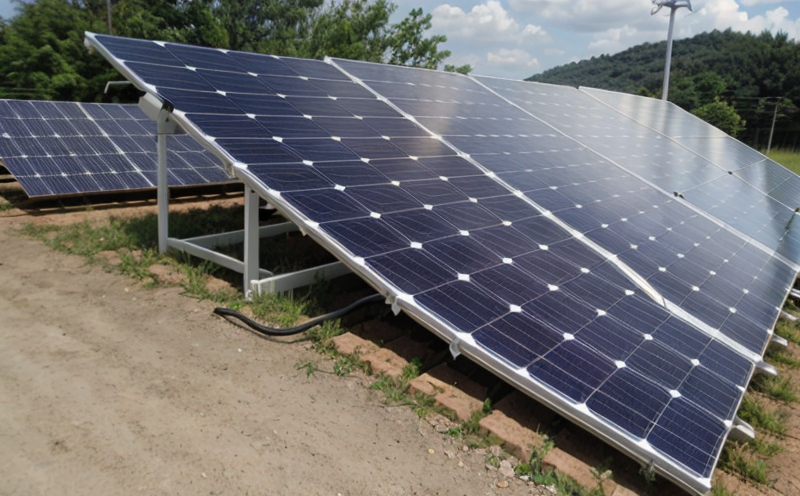IEC 61215-2 Bending Stress Testing
The IEC 61215-2 standard is a crucial document that sets forth the requirements for photovoltaic (PV) modules, including structural integrity tests to ensure they can withstand the rigors of real-world conditions. Among these, bending stress testing evaluates how well solar panels and photovoltaic modules hold up under mechanical loads. This type of test is essential in ensuring the longevity and reliability of PV systems, which are integral components of renewable energy infrastructure.
Bending stress tests are particularly important because they assess a module's ability to resist deformation or failure due to external forces such as wind load, snow accumulation, or physical impacts. These factors can significantly influence the performance and durability of solar panels installed in various environments. For instance, modules used in areas prone to high winds need to be robust enough to maintain optimal power output without sustaining damage.
The test procedure involves subjecting a sample PV module to specified bending stresses while monitoring its behavior under load. The apparatus typically includes a testing frame capable of applying controlled loads along the longer edges or centerline of the panel. This setup allows engineers to simulate real-world conditions that might cause strain on the material, such as those encountered during installation or operation.
During the test, technicians apply a defined bending moment to the module and observe whether any cracks form in the glass substrate, backsheet, or encapsulant materials. They also measure the deflection of the panel under load, which provides valuable insights into its structural integrity. Compliance with IEC 61215-2 ensures that manufacturers produce products meeting international quality standards, thereby enhancing confidence among end users and stakeholders.
The importance of this testing cannot be overstated in today's rapidly growing solar energy sector. As countries around the world aim to reduce carbon emissions by increasing reliance on renewable sources like solar power, there is an increased need for robust, reliable PV modules that can operate efficiently over extended periods without degradation. By adhering strictly to IEC 61215-2 requirements during manufacturing processes, companies contribute positively towards achieving these goals while also protecting their reputations and customer satisfaction.
Moreover, successful completion of bending stress tests demonstrates adherence to best practices within the industry, fostering trust among clients who value sustainability initiatives. It helps establish credibility not just locally but globally as well, opening up opportunities for international collaborations and market expansion.
Why It Matters
The significance of IEC 61215-2 bending stress testing lies in its role as a critical quality assurance measure ensuring that solar panels meet stringent performance expectations. This standard plays a vital part in maintaining the integrity and reliability of photovoltaic systems, which form the backbone of many renewable energy projects.
By subjecting modules to controlled mechanical loads during bending stress tests, researchers can identify potential weaknesses or failures before they become operational issues leading to costly repairs or replacements. Such proactive measures not only extend the lifespan of PV installations but also enhance overall system efficiency and reduce maintenance costs over time.
In addition, compliance with IEC 61215-2 helps manufacturers stay competitive in an increasingly demanding market where customer confidence is paramount. When consumers choose solar products based on recognized international standards like this one, they demonstrate support for environmentally responsible practices that contribute to global sustainability goals.
Furthermore, the results of these tests provide valuable data for continuous improvement initiatives aimed at enhancing product quality and durability. Manufacturers can use this information to fine-tune production processes, optimize material selection, and implement design changes that improve resistance against environmental stresses without compromising on aesthetics or functionality.
Scope and Methodology
The scope of IEC 61215-2 bending stress testing encompasses the evaluation of structural integrity through mechanical loading applied to photovoltaic modules. According to this standard, the test aims to assess how well a module can withstand external forces that may occur during installation or operational use.
For the bending stress test, a sample PV module is mounted on a specially designed testing frame capable of applying defined loads along either its longer edges or centerline. The apparatus ensures precise control over applied forces and displacement, allowing for accurate measurements throughout the process.
- The bending moment applied should be within specified limits outlined in IEC 61215-2.
- Measurements include monitoring deflection at various points along the module’s length as well as checking for any visible cracks or deformations in key areas such as the glass cover, backsheet material, and encapsulant layer.
Once testing is complete, all data collected during the experiment must be analyzed thoroughly. This includes evaluating whether the module passed or failed based on predefined acceptance criteria provided by IEC 61215-2. Compliance with these standards ensures that manufacturers deliver products meeting global quality benchmarks.





